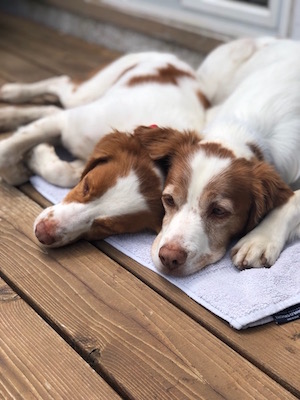
My sister’s two dogs, Indy (left) and Levi (right)
The sheer number of dogs we have in the U.S. has led a few researchers to look at the impact they have on our environment. That means considering their food, their waste, and the many things we buy for them. (1) Once we understand their impact, we can identify ways we can be more environmentally-friendly dog owners. Here is a summary — ten ways to reduce a dog’s “pawprint” — for those that want to skip to the chase. Many of these seem obvious, but our household does few of them right now, and some would be a big change.
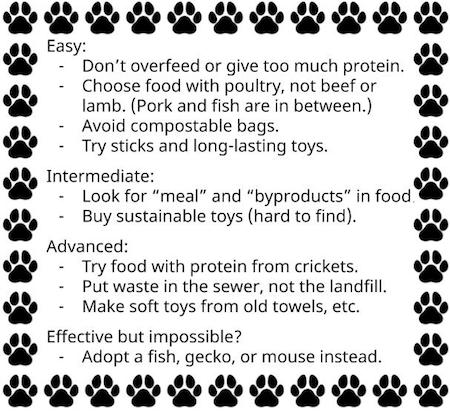
Let’s start with diet. Dogs eat a lot of food. More than that, they eat a lot of protein, which often has a particularly high environmental impact. Gregory Olin of UCLA reports (2) that while 20% of Americans’ calories are from meat, dogs get about one-third of their calories from animal sources. Since they eat an estimated 1300 calories per day on average, it adds up. Olin writes “If just one-quarter of the … animal-derived energy in pet food was consumable by humans, it alone would support ... the entire energy requirement of almost 5 million Americans, or approximately the population of Colorado.” While his estimate incorporates both dog and cat food, dogs account for about 80% of that.
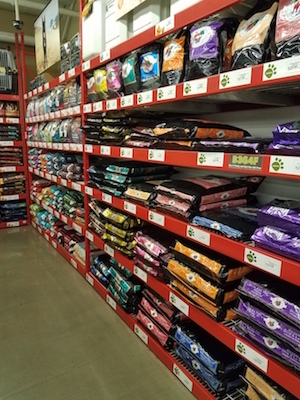
Bags of dog food line the shelves of a local pet store
How can dogs create such a big demand on our food supply? Part of the problem is that we overfeed our dogs. According to a recent survey of about 1500 dogs, 37% were overweight and 19% were obese. In other words, well over half our dogs are overweight or obese. But it’s not just that we feed them too much. Many households (38%, per Olin) feed their dogs “premium” food, which has more protein and more protein from animal sources. A rule of thumb for dogs is that they should have 1 gram of protein for each pound of weight. A diet of 18% – 25% protein is plenty for adult dogs. But many dog foods contain more than that. A quick check of Wellness dog foods shows protein content ranges from 22% for their “Complete Health” food to 34% for “CORE Six” and even more (36%) for “CORE RawRev”. In addition to having more protein, the higher-end dog foods rely more on meat for their proteins. When you put it all together, Olin calculates that premium dog foods get 47% of their calories from animal sources, compared to 25% for “market-leading” dog foods. (3)

A selection of Wellness dog foods
The Pet Sustainability Coalition (PSC) hosted a webinar late last year on sustainable proteins for pet food. You can read a summary here. PSC worked with Iowa State University to evaluate the environmental impact of different types of proteins in pet food. Cattle and sheep (lamb) have the largest emissions, though fish does poorly in other areas, particularly impact on water quality. Poultry and pork are the best options, which is not too surprising. But PSC makes some additional points. One is that proteins that come from meat byproducts (e.g., kidney, heart, lung, and similar) have lower impact than those that come from meat that people (Americans) typically eat. The chart below shows the greenhouse gas emissions of different types of proteins, with the darker tones showing byproducts and the lighter tones showing human-grade meat. Meat byproducts have much lower greenhouse gas emissions.

Greenhouse gas emissions of different protein sources, with darker shades showing meat byproducts and lighter shades showing human-grade meat. (Source: Pet Sustainability Coalition webinar)
Although they are nutritious for dogs, there are some marketing and educational challenges with these ingredients along with some emotional resistance from consumers. (4)

A common marketing message on dog food.
PSC also reviews some new protein sources that can be good options, though they are not yet widely available and so are likely to be pretty expensive.

Alternative pet food proteins with lower impact. (Source: Pet Sustainability Coalition webinar)
I thought I’d try out the cricket-based treats and dog food. I wasn’t able to find any at local stores, though the worker at Petco seemed intrigued when I asked, and jotted down some notes. (Don’t be afraid to ask for climate-friendly products!) Chewy stocks items from Jiminy’s. (5) I ordered three flavors of treats and one small bag of dog food.

Jiminy products that my dog tried: one bag of food and three types of treats
Our dog (a lab and pit mix) eats bugs and most everything else, so I was optimistic she would like these. Indeed, she snarfed them down. I tried to figure out which she liked best, but after a number of experiments, she seemed to just prefer whichever was closest to her, and then would quickly snarf up the others.
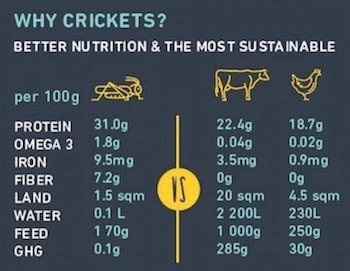
Nutritional and environmental information about crickets (Source: Jiminy dog treats)
Dog food, whether cricket-based or cow-based, ends up as poop. Dogs eat a lot of food, so they make a lot of poop. Olin estimates the “wet weight” (ugh) at around one-third pound per dog, or about a burger’s worth (double-ugh). (6) He summarizes the total output, so to speak, as follows: “Assuming that Americans throw away about 2kg garbage each day, if all of the feces from dogs and cats … were disposed as garbage, (it) would be equivalent to all the garbage produced by 6.63M Americans, or about the population of Massachusetts.” Palo Alto reports that animal waste is one of the top landfilled items from single-family homes, though the relevant category includes more than dog poop. (7)
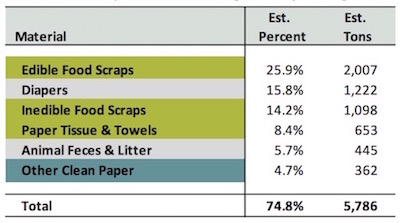
Animal waste is the second largest component of Palo Alto’s single-family-home waste that cannot be composted or recycled. (Source: Palo Alto Waste Characterization Study, 2017)
All righty, so what are our options for dog waste? It doesn’t recycle (no surprise), but it also doesn’t compost. When I visited a local composting facility a year ago, the Director of Sustainability, Michael Gross, mentioned to me that pet waste is not allowed because of odor and flies. Julia Au of RethinkWaste in San Carlos said that the primary issue in their service area is actually customer discomfort. “There is a current stigma within the community about waste turning into compost, which could be used to grow food.” Eric Vidal of Palo Alto’s Zero Waste confirms the same problem of marketing the resulting compost. No facility in the area accepts dog waste in compost.
So if we can’t compost it or recycle it, is landfill the best option? We really don’t want organics in the landfill, and SB 1383 requires that we reduce landfilled organics by 75% in the next few years. That means, for one thing, that those compostable poop bags are a bad idea if you are throwing waste in the garbage. Plastic (especially reused plastic) is better. But there are a few ways to bypass the landfill entirely.
One option is to put the dog waste in the toilet. Joanna Tran, who works in Palo Alto’s water quality control, says it’s fine to put poop in the toilet as long as there is not a bag or other items with it. (Socks, anyone?) Lori Topley, Program Manager for Mountain View’s Solid Waste program, pointed me to a sewer line attachment that allows you to deposit waste in the sewer without taking it indoors. You just need a hose close enough to your cleanout so you can “flush” each deposit.
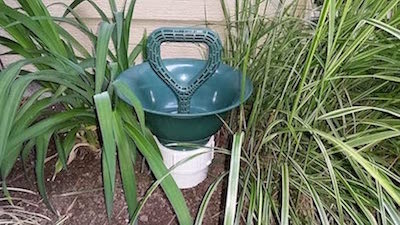
The Doggie Doo Drain, for sale on both Amazon and Chewy
Topley also pointed me to another option, a pet waste digester. If your yard has soil with adequate drainage, you dig a deep hole, fit the digester in, and then add waste, tablets, and water as needed, much like a septic tank. (Some reviewers say a plain plastic bucket, or even just a covered hole, would do the job equally well.)
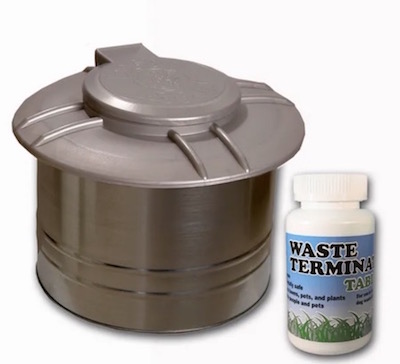
The Doggie Dooley in-ground pet waste digester, for sale on both Amazon and Chewy
I’m going to try the “put it in the toilet” routine, using compostable bags that then go (emptied) in the compost. It’s going to be hard to get in the habit, though. We’ll see...
Finally, I want to mention all the things we buy for the pets we love. Our dog turned five recently, and I bought her way too many stuffed animals. She would have been just as happy with a few good sticks. Our last dog loved pine cones. Both of them seem to like older toys better than newer ones. Long-lasting Kongs and Nylabones have been a hit with our dogs. So there are lots of ways to reduce “stuff”. It’s hard for me to evaluate the “eco-friendly” claims in toy descriptions, so I would suggest the following rules of thumb. I’d love your ideas as well:
- Fewer toys is better. Just like we overfeed our dogs, we also overtoy them.
- Toys that you don’t need to buy are great (e.g., sticks, old soccer balls, or simple DIY toys).
- Long-lasting toys are better.
- Items made from recycled materials are preferable, but they are not easy to find. I did see this display of Spunky Pup’s Clean Earth line at our local PetSmart, but nothing at other local stores.

These Spunky Pup Clean Earth items at PetSmart are made from 100% recycled plastic water bottles.
Beco Pets has some good products. Chuck-It makes recycled balls. A number of beds use stuffings like PlanetFill and IntelliLoft that are made from recycled plastic. But reduce and reuse are preferable.

My sister’s dogs, Levi and Indy, when Indy was young
When I wrote about emissions from flying a while ago, some people were upset. Long-distance travel means a lot to them and they didn’t want to contemplate cutting back. I expect even more people are attached to their dogs. I sure am. As with everything, different adjustments make sense for different people. For all of you who can’t imagine living without a dog, there are plenty of ways to make a big dent in your pet’s impact. I hope this post gives you some ideas. For our dog, I am going to try to adopt new food and toy habits, which I expect to be easy, and also give sewer disposal a shot, which I’m less optimistic about. I’d love to hear your thoughts or experiences.
Notes and References
1. The services we use for our dogs, like health care and grooming, also have an environmental impact but are not discussed here.
2. Gregory Olin’s report, “Environmental impacts of food consumption by dogs and cats,” was released in 2017 and widely reviewed by the popular press. The calculations have a number of assumptions, as he points out, but even with haircuts the impacts are large.
3. I asked the makers of Wellness and Orijen dog foods what steps they are taking (or have taken) to reduce the environmental impact of their foods, but I did not hear back.
4. Animal components other than muscle meat are referred to as meat “byproducts” or (when fat and water are removed) “meal” on pet food labels. The Association of American Feed Control Officials explains in some detail what is included and what is not in these items. The veterinary school at Tufts has a brief overview of their nutritious value. UC Davis writes something on that as well.
5. You can also find cricket-based dog food at Chippin. Rover has an overview of cricket-based foods for dogs (and for people). Some of you may be interested in putting cricket flour onto homemade vegetarian dog food.
6. Surprisingly (to me), some researchers have developed power laws for poop production in dogs. (I am not kidding.) Aren’t you glad you read the footnotes?
7. Palo Alto includes a number of things in the category of “animal feces and litter,” namely “any non-human animal feces and litter such as cat feces and kitty litter, dog poop, bird droppings, and horse manure and soiled bedding. Includes soiled paper and other litter materials. Also includes animal carcasses not resulting from food storage or preparation.”
Current Climate Data (July/August 2020)
Global impacts, US impacts, CO2 metric, Climate dashboard (updated annually)
No pictures this week, you can just look out the window...
A Public Service Announcement...
Where do Palo Alto City Council candidates stand on climate? Listen in on October 6.
Comment Guidelines
I hope that your contributions will be an important part of this blog. To keep the discussion productive, please adhere to these guidelines or your comment may be moderated:
- Avoid disrespectful, disparaging, snide, angry, or ad hominem comments.
- Stay fact-based and refer to reputable sources.
- Stay on topic.
- In general, maintain this as a welcoming space for all readers.



